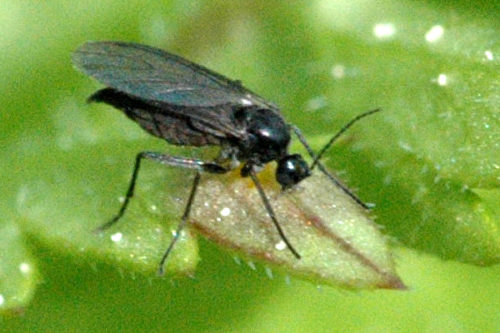Dark-winged fungus gnats belong to the flies among the two-winged flies; worldwide, this family has 92 genera and 2455 species.
Also known as:
Sciarid midge
Do not confuse with:
Hawthorn fly
Dark-winged fungus gnat (Sciara analis). The few-mm-large fungus gnats belong to the flies order Diptera. Worldwide, this family has 92 genera and 2455 species.
These tiny, blackflies live off fungi and mosses on decaying organic waste. So you’ll find them in the kerbside garden / food waste bin outside and indoors around houseplants and herb pots. After all, potting soil contains a lot of decayed organic matter.
Flying around, the fungus gnats do little harm; the same is not true of the larvae that hatch from the many (200!) eggs the dark-winged fungus gnat has laid in the earth. They multiply very quickly. The larvae feast on plant roots and can cause extensive damage. Dark-winged fungus gnats live only a short time: after one or two days they die.
Where to find
- Houseplants
- Kerbside garden / food waste bin
Control
An infestation of fungus gnats is not easily controlled; instead, the approach using the roundworm Steinernema Feltiae works well. The roundworms attack the larvae in the pot: Steinernema nematodes.
Prevention
Use fresh potting soil; old potting soil is attractive to fungus gnats due to the presence of fungi. Clean up plant waste; regularly change decorative pots and saucers under houseplants. For many houseplants in a greenhouse, preventive application of roundworms is recommended.

